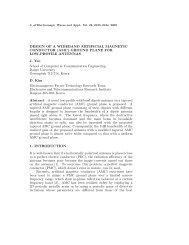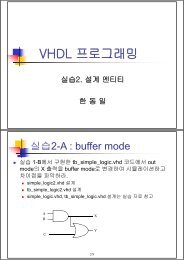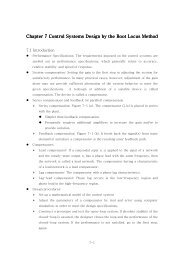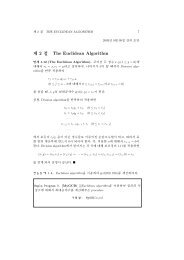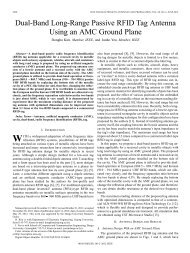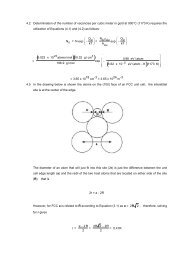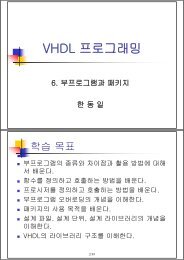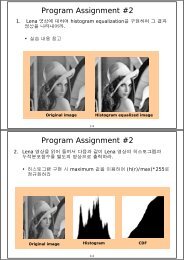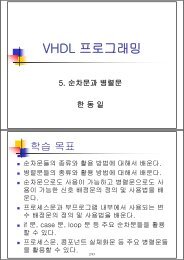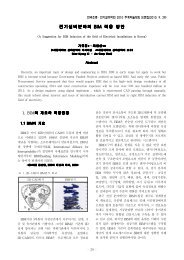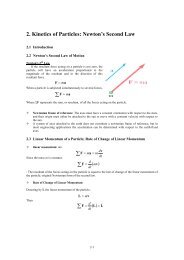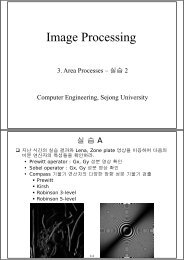Classification of rice cultivars based on cluster analysis of hydration ...
Classification of rice cultivars based on cluster analysis of hydration ...
Classification of rice cultivars based on cluster analysis of hydration ...
Create successful ePaper yourself
Turn your PDF publications into a flip-book with our unique Google optimized e-Paper software.
<str<strong>on</strong>g>Classificati<strong>on</strong></str<strong>on</strong>g> <str<strong>on</strong>g>of</str<strong>on</strong>g> <str<strong>on</strong>g>rice</str<strong>on</strong>g> <str<strong>on</strong>g>cultivars</str<strong>on</strong>g> <str<strong>on</strong>g>based</str<strong>on</strong>g> <strong>on</strong> <strong>cluster</strong> <strong>analysis</strong> <str<strong>on</strong>g>of</str<strong>on</strong>g> hydrati<strong>on</strong> and pasting<br />
properties <str<strong>on</strong>g>of</str<strong>on</strong>g> their starches<br />
Inae Lee a , Gyoung Jin We a , D<strong>on</strong>g Eun Kim a , Y<strong>on</strong>g-Sik Cho b , Mi-Ra Yo<strong>on</strong> c , Malshick Shin d ,<br />
Sangho<strong>on</strong> Ko a, *<br />
a Department <str<strong>on</strong>g>of</str<strong>on</strong>g> Food Science and Technology, Sej<strong>on</strong>g University, 98 Gunja-d<strong>on</strong>g, Gwangjin-gu, Seoul 143-747, Republic <str<strong>on</strong>g>of</str<strong>on</strong>g> Korea<br />
b Nati<strong>on</strong>al Academy <str<strong>on</strong>g>of</str<strong>on</strong>g> Agricultural Science, Rural Development Administrati<strong>on</strong>, Suw<strong>on</strong> 441-707, Republic <str<strong>on</strong>g>of</str<strong>on</strong>g> Korea<br />
c Nati<strong>on</strong>al Institute <str<strong>on</strong>g>of</str<strong>on</strong>g> Crop Science, Rural Development Administrati<strong>on</strong>, Suw<strong>on</strong> 441-707, Republic <str<strong>on</strong>g>of</str<strong>on</strong>g> Korea<br />
d Department <str<strong>on</strong>g>of</str<strong>on</strong>g> Food and Nutriti<strong>on</strong>, Ch<strong>on</strong>nam Nati<strong>on</strong>al University, Gwangju 500-757, Republic <str<strong>on</strong>g>of</str<strong>on</strong>g> Korea<br />
article info<br />
Article history:<br />
Received 22 September 2011<br />
Received in revised form<br />
16 February 2012<br />
Accepted 2 March 2012<br />
Keywords:<br />
Rice<br />
Starch<br />
Pasting property<br />
Cluster <strong>analysis</strong><br />
Cultivars<br />
<str<strong>on</strong>g>Classificati<strong>on</strong></str<strong>on</strong>g><br />
1. Introducti<strong>on</strong><br />
abstract<br />
Rice starch has attracted attenti<strong>on</strong> for use in baby foods, extruded<br />
products, soups, and dressings due to its small-size starch granules,<br />
neutral taste, and s<str<strong>on</strong>g>of</str<strong>on</strong>g>t mouth feel (Mitchell, 2009). However, Rice<br />
starch industry is suffering from inefficiency in securing the uniform<br />
quality ingredient since <str<strong>on</strong>g>rice</str<strong>on</strong>g> commodities that are traded involve<br />
a wide variety <str<strong>on</strong>g>of</str<strong>on</strong>g> <str<strong>on</strong>g>cultivars</str<strong>on</strong>g>, and each <str<strong>on</strong>g>rice</str<strong>on</strong>g> cultivar possesses unique<br />
processability. Especially, there exists a significant difference in<br />
physicochemical properties even am<strong>on</strong>g the starches obtained from<br />
<str<strong>on</strong>g>rice</str<strong>on</strong>g> <str<strong>on</strong>g>cultivars</str<strong>on</strong>g> with similar amylose c<strong>on</strong>tent (Choi, 2002; Ha et al.,<br />
2007; Yo<strong>on</strong>, Koh, & Kang, 2009). From the industrial standpoint, it<br />
is a realistic approach to simplify <str<strong>on</strong>g>rice</str<strong>on</strong>g> <str<strong>on</strong>g>cultivars</str<strong>on</strong>g> categorizati<strong>on</strong> in<br />
order to c<strong>on</strong>trol the <str<strong>on</strong>g>rice</str<strong>on</strong>g> quality at all times. Thus, it is plausible to<br />
classify the <str<strong>on</strong>g>rice</str<strong>on</strong>g> starches categorized by similarity <strong>on</strong> the processability<br />
<str<strong>on</strong>g>of</str<strong>on</strong>g> their species after selecting those by its food-applicable<br />
properties for appropriate management <str<strong>on</strong>g>of</str<strong>on</strong>g> <str<strong>on</strong>g>rice</str<strong>on</strong>g> starch quality. It is<br />
* Corresp<strong>on</strong>ding author. Tel.: þ82 2 3408 3260; fax: þ82 2 3408 4319.<br />
E-mail addresses: cwddzz@naver.com (I. Lee), playmaker11@navr.com (G.J. We),<br />
idb7576@daum.net (D.E. Kim), yscho@rda.go.kr (Y.-S. Cho), mryo<strong>on</strong>12@rda.go.kr<br />
(M.-R. Yo<strong>on</strong>), msshin@jnu.ac.kr (M. Shin), sangho<strong>on</strong>ko@sej<strong>on</strong>g.ac.kr (S. Ko).<br />
0023-6438/$ e see fr<strong>on</strong>t matter Ó 2012 Elsevier Ltd. All rights reserved.<br />
doi:10.1016/j.lwt.2012.03.002<br />
LWT - Food Science and Technology 48 (2012) 164e168<br />
C<strong>on</strong>tents lists available at SciVerse ScienceDirect<br />
LWT - Food Science and Technology<br />
journal homepage: www.elsevier.com/locate/lwt<br />
The aim <str<strong>on</strong>g>of</str<strong>on</strong>g> this study was to classify different <str<strong>on</strong>g>rice</str<strong>on</strong>g> <str<strong>on</strong>g>cultivars</str<strong>on</strong>g> <str<strong>on</strong>g>based</str<strong>on</strong>g> <strong>on</strong> their starches processability indicators<br />
such as hydrati<strong>on</strong> and pasting properties instead <str<strong>on</strong>g>of</str<strong>on</strong>g> c<strong>on</strong>venti<strong>on</strong>al approach <str<strong>on</strong>g>based</str<strong>on</strong>g> <strong>on</strong> amylose<br />
c<strong>on</strong>tent. Hydrati<strong>on</strong> and pasting properties <str<strong>on</strong>g>of</str<strong>on</strong>g> <str<strong>on</strong>g>rice</str<strong>on</strong>g> starches from 12 different <str<strong>on</strong>g>cultivars</str<strong>on</strong>g> (A to L) were<br />
analyzed, and corresp<strong>on</strong>ding parameters were used to classify the <str<strong>on</strong>g>cultivars</str<strong>on</strong>g> by a hierarchical <strong>cluster</strong><br />
<strong>analysis</strong>. Twelve <str<strong>on</strong>g>rice</str<strong>on</strong>g> <str<strong>on</strong>g>cultivars</str<strong>on</strong>g> were classified <str<strong>on</strong>g>based</str<strong>on</strong>g> <strong>on</strong> the pasting parameters (AJ/B/CDGI/EFH/K/L), the<br />
hydrati<strong>on</strong> parameters (ACDGJ/BEFHI/K/L), and their combinati<strong>on</strong> (ACDGJ/BEFHI/K/L). The classificati<strong>on</strong><br />
<str<strong>on</strong>g>based</str<strong>on</strong>g> <strong>on</strong> the amylose c<strong>on</strong>tent (AB/CDEFGHIJ/KL) is different from that <str<strong>on</strong>g>based</str<strong>on</strong>g> <strong>on</strong> hydrati<strong>on</strong> and/or pasting<br />
characteristics. Especially, <str<strong>on</strong>g>cultivars</str<strong>on</strong>g> C, D, and G and <str<strong>on</strong>g>cultivars</str<strong>on</strong>g> E, F, and H have been separated into different<br />
groups although they were found to possess similar amylose c<strong>on</strong>tent. The group having <str<strong>on</strong>g>cultivars</str<strong>on</strong>g> E, F, and<br />
H showed higher water absorpti<strong>on</strong> index, swelling power, and pasting viscosities than the group <str<strong>on</strong>g>of</str<strong>on</strong>g> C, D,<br />
and G <str<strong>on</strong>g>cultivars</str<strong>on</strong>g>. This study provides a resoluti<strong>on</strong> to standardize purpose-specific starches from a variety<br />
<str<strong>on</strong>g>of</str<strong>on</strong>g> <str<strong>on</strong>g>rice</str<strong>on</strong>g> <str<strong>on</strong>g>cultivars</str<strong>on</strong>g>.<br />
Ó 2012 Elsevier Ltd. All rights reserved.<br />
necessary to reflect their actual competence in order to distinguish<br />
<str<strong>on</strong>g>based</str<strong>on</strong>g> <strong>on</strong> the characteristics <str<strong>on</strong>g>of</str<strong>on</strong>g> <str<strong>on</strong>g>rice</str<strong>on</strong>g> starch. So far, amylose c<strong>on</strong>tent<br />
and amylose/amylopectin ratio have been used to distinguish the<br />
<str<strong>on</strong>g>rice</str<strong>on</strong>g> starch characteristics (Hall & Johns<strong>on</strong>, 1966; Juliano, 1985; Kum,<br />
Lee, Lee, & Lee, 1996). However, neither amylose c<strong>on</strong>tent nor<br />
amylose/amylopectin ratio <str<strong>on</strong>g>of</str<strong>on</strong>g> <str<strong>on</strong>g>rice</str<strong>on</strong>g> starch has reflected properly the<br />
processing suitability parameters such as swelling power and<br />
pasting property. A wide variety <str<strong>on</strong>g>of</str<strong>on</strong>g> <str<strong>on</strong>g>rice</str<strong>on</strong>g> <str<strong>on</strong>g>cultivars</str<strong>on</strong>g> can be classified into<br />
several groups <str<strong>on</strong>g>based</str<strong>on</strong>g> <strong>on</strong> their processability instead <str<strong>on</strong>g>of</str<strong>on</strong>g> amylose<br />
c<strong>on</strong>tent or amylose/amylopectin ratio.<br />
Recently, hydrati<strong>on</strong> and rapid visco <strong>analysis</strong> (RVA) parameters<br />
have been c<strong>on</strong>sidered to study the processability <str<strong>on</strong>g>of</str<strong>on</strong>g> starches<br />
(Adebowale & Lawal, 2003). Herein, we hypothesize that proper<br />
interpretati<strong>on</strong> <str<strong>on</strong>g>of</str<strong>on</strong>g> the analytical results <str<strong>on</strong>g>of</str<strong>on</strong>g> <str<strong>on</strong>g>rice</str<strong>on</strong>g> processability indicators<br />
such as hydrati<strong>on</strong> and pasting parameters could provide a new<br />
classificati<strong>on</strong> <str<strong>on</strong>g>of</str<strong>on</strong>g> <str<strong>on</strong>g>rice</str<strong>on</strong>g> <str<strong>on</strong>g>cultivars</str<strong>on</strong>g> fulfilling food industry needs. The RVA is<br />
<strong>on</strong>e <str<strong>on</strong>g>of</str<strong>on</strong>g> major analytical methods to determine starch quality in food<br />
industry. The RVA pr<str<strong>on</strong>g>of</str<strong>on</strong>g>iles have been extensively used for pasting<br />
comparis<strong>on</strong> studies in starch applicati<strong>on</strong>s (Bhattacharya, Zee, &<br />
Corke, 1999; Limpisut & Jindal, 2002; Wiesenborn, Orr, Casper, &<br />
Tacke, 1994). Starch processability characteristics can be indirectly<br />
inferred from the quantitative RVA pr<str<strong>on</strong>g>of</str<strong>on</strong>g>ile parameters such as peak
time, pasting temperature, peak viscosity, trough viscosity, final<br />
viscosity, breakdown, and setback. Other important parameters<br />
which represent processability are hydrati<strong>on</strong> properties: water<br />
absorpti<strong>on</strong> index, water solubility, and swelling power (Crosbie,1991;<br />
Li & Yeh, 2001). The hydrati<strong>on</strong> properties <str<strong>on</strong>g>of</str<strong>on</strong>g> starches can be correlated<br />
with their pasting behaviors which are important for the determinati<strong>on</strong><br />
<str<strong>on</strong>g>of</str<strong>on</strong>g> starch quality. In many cases, a single parameter from<br />
different measures rarely reflects whole characteristics <str<strong>on</strong>g>of</str<strong>on</strong>g> a starch. In<br />
additi<strong>on</strong>, it is difficult to classify the <str<strong>on</strong>g>rice</str<strong>on</strong>g> starches intuitively <str<strong>on</strong>g>based</str<strong>on</strong>g> <strong>on</strong><br />
the parameters because <str<strong>on</strong>g>of</str<strong>on</strong>g> the complexity <str<strong>on</strong>g>of</str<strong>on</strong>g> them.<br />
To overcome these issues, statistical categorizati<strong>on</strong> such as<br />
<strong>cluster</strong>ing can be used as an alternative approach to obtain<br />
a comm<strong>on</strong> pattern from complex data sets <str<strong>on</strong>g>of</str<strong>on</strong>g> hydrati<strong>on</strong> and pasting<br />
parameters. Cluster <strong>analysis</strong> is a statistical method to c<strong>on</strong>vert<br />
various characteristics <str<strong>on</strong>g>of</str<strong>on</strong>g> objects to quantitative measures (so<br />
called similarity distance) and corresp<strong>on</strong>dingly to <strong>cluster</strong> them at<br />
relatively close distances into a category (Endo, Okada, Nagao, &<br />
D’appl<strong>on</strong>ia, 1990). We hypothesize that the <strong>cluster</strong> <strong>analysis</strong> can be<br />
used to categorize the <str<strong>on</strong>g>rice</str<strong>on</strong>g> <str<strong>on</strong>g>cultivars</str<strong>on</strong>g> having similar hydrati<strong>on</strong> and<br />
pasting parameters into single group. In this approach, starches<br />
from different <str<strong>on</strong>g>cultivars</str<strong>on</strong>g> but with similar processability properties<br />
can be assumed as a single commodity for easy identificati<strong>on</strong> and<br />
selecti<strong>on</strong> by starch industry for specific applicati<strong>on</strong> purposes.<br />
In this study, <str<strong>on</strong>g>rice</str<strong>on</strong>g> starches were extracted from 12 different<br />
<str<strong>on</strong>g>cultivars</str<strong>on</strong>g> and their processability parameters were measured; they<br />
are categorized into several groups by <strong>cluster</strong> <strong>analysis</strong> <str<strong>on</strong>g>of</str<strong>on</strong>g> the processability<br />
parameters. In additi<strong>on</strong>, the texture properties <str<strong>on</strong>g>of</str<strong>on</strong>g> these <str<strong>on</strong>g>rice</str<strong>on</strong>g><br />
starches were also determined to validate the categorizati<strong>on</strong>.<br />
2. Materials and methods<br />
2.1. Materials<br />
Twelve <str<strong>on</strong>g>rice</str<strong>on</strong>g> <str<strong>on</strong>g>cultivars</str<strong>on</strong>g> are listed in Table 1 and were grown at the<br />
Nati<strong>on</strong>al Institute <str<strong>on</strong>g>of</str<strong>on</strong>g> Crop Science, Rural Development Administrati<strong>on</strong>,<br />
Korea in 2009. The grains <str<strong>on</strong>g>of</str<strong>on</strong>g> each <str<strong>on</strong>g>rice</str<strong>on</strong>g> cultivar was polished<br />
to separate husk and bran and subsequently stored for further<br />
starch preparati<strong>on</strong>.<br />
2.2. Rice starch preparati<strong>on</strong><br />
Rice starch from each cultivar was isolated by an alkaline<br />
steeping method (Yamamoto, Sawada, & Onogaki, 1973).<br />
2.3. Amylose c<strong>on</strong>tent measurement<br />
Amylose c<strong>on</strong>tent <str<strong>on</strong>g>of</str<strong>on</strong>g> the <str<strong>on</strong>g>rice</str<strong>on</strong>g> starches was determined by using<br />
the iodine test (Williams, Kuzina, & Hlynka, 1970).<br />
Table 1<br />
Amylose c<strong>on</strong>tents <str<strong>on</strong>g>of</str<strong>on</strong>g> <str<strong>on</strong>g>rice</str<strong>on</strong>g> starches extracted from different <str<strong>on</strong>g>cultivars</str<strong>on</strong>g>.<br />
Symbols Amylose c<strong>on</strong>tent (g/100 g) Name <str<strong>on</strong>g>of</str<strong>on</strong>g> the cultivar<br />
A High amylose 33.84 0.47 a<br />
Goami<br />
B 29.16 0.71 b<br />
Thailand<br />
C Medium amylose 22.05 1.33 c<br />
Seolgaeng<br />
D 21.73 0.51 dc<br />
Hiami<br />
E 21.44 0.2 d<br />
Ilmi<br />
F 21.35 0.32 d<br />
Hanareum<br />
G Low amylose 19.44 0.17 e<br />
Hopye<strong>on</strong>g<br />
H 17.97 0.37 f<br />
Deuraechan<br />
I 17.92 0.18 f<br />
Hanmauem<br />
J 17.62 0.23 f<br />
D<strong>on</strong>gjin 1<br />
K Waxy 1.70 0.12 g<br />
Boseokchal<br />
L 1.32 0.56 g<br />
Shinse<strong>on</strong>chal<br />
Means with the different letters in the same column are significantly different at the<br />
5% level.<br />
I. Lee et al. / LWT - Food Science and Technology 48 (2012) 164e168 165<br />
2.4. Measurement <str<strong>on</strong>g>of</str<strong>on</strong>g> water absorpti<strong>on</strong> index, water solubility, and<br />
swelling power<br />
Water absorpti<strong>on</strong> index (WAI) was measured according to the<br />
method <str<strong>on</strong>g>of</str<strong>on</strong>g> Medcalf and Gilles (1965). Water solubility (WS) and<br />
swelling power (SP) were determined following the method <str<strong>on</strong>g>of</str<strong>on</strong>g><br />
Schoch (1964). For the <strong>analysis</strong> <str<strong>on</strong>g>of</str<strong>on</strong>g> hydrati<strong>on</strong> properties, starch<br />
suspensi<strong>on</strong> was heated at 80 C. Three hydrati<strong>on</strong> parameters were<br />
calculated using the following equati<strong>on</strong>:<br />
Water Absorpti<strong>on</strong> Index ðWAIÞ ¼<br />
Water Solubility ðWS; %Þ ¼<br />
wet sediment weight<br />
dry sample weight<br />
dry supernatant weight<br />
dry sample weight<br />
100<br />
wet sediment weight<br />
Swelling Power ðSPÞ ¼<br />
WS ð%Þ<br />
dry sample weight 1<br />
100<br />
2.5. Measurement <str<strong>on</strong>g>of</str<strong>on</strong>g> pasting properties<br />
Pasting properties <str<strong>on</strong>g>of</str<strong>on</strong>g> starch samples were measured using<br />
a rheometer equipped with a starch pasting cell (AR 1500ex, TA<br />
instrument, New Castle, DE, USA) which can be operated like<br />
a rapid visco-analyzer (RVA). Three grams (dry weight) <str<strong>on</strong>g>of</str<strong>on</strong>g> starch<br />
sample was added to 25 g <str<strong>on</strong>g>of</str<strong>on</strong>g> distilled water in a aluminum vessel<br />
(37 mm internal diameter and 65 mm height) installed <strong>on</strong> the<br />
rheometer. The starch suspensi<strong>on</strong> was stirred at 25 C for 1 min by<br />
a plastic paddle. During the measurement, a time-temperature<br />
schedule was applied; the starch suspensi<strong>on</strong> was heated to 95 C<br />
(starting from 25 C, at a rising temperature rate <str<strong>on</strong>g>of</str<strong>on</strong>g> 12 C/min), held<br />
at 95 C for 2.5 min, cooled down to 50 C at a rate <str<strong>on</strong>g>of</str<strong>on</strong>g> 12 C/min,<br />
and held at that temperature for 2 min. The pasting parameters,<br />
peak time, pasting temperature, and peak (P), trough (T), final (F),<br />
breakdown (PeT), and setback (FeT) viscosity parameters were<br />
determined in situ for the starch suspensi<strong>on</strong>.<br />
2.6. Texture pr<str<strong>on</strong>g>of</str<strong>on</strong>g>ile <strong>analysis</strong> <str<strong>on</strong>g>of</str<strong>on</strong>g> starch gels<br />
For the texture pr<str<strong>on</strong>g>of</str<strong>on</strong>g>ile <strong>analysis</strong>, 2.4 g <str<strong>on</strong>g>of</str<strong>on</strong>g> each starch sample (dry<br />
weight) was added to 27.6 mL <str<strong>on</strong>g>of</str<strong>on</strong>g> distilled water in a 100 mL screw<br />
cap bottle (40 mm opening) at 25 C under stirring c<strong>on</strong>diti<strong>on</strong>s<br />
(700 rpm for 30 min). The bottles were heated by immersi<strong>on</strong> in<br />
a water bath at 85 C for 30 min and then cooled to 25 C. Subsequently,<br />
the bottles were sealed with screw cap and stored at 4 C<br />
for 24 h. Each bottle including the starch gel prepared was placed<br />
<strong>on</strong> a texture analyzer (TMS-Pro, Food Technology Co., Sterling, VA,<br />
USA) equipped with a 25 N load cell. The starch gel was compressed<br />
5 mm at pretest a speed <str<strong>on</strong>g>of</str<strong>on</strong>g> 50 mm/min, test speed <str<strong>on</strong>g>of</str<strong>on</strong>g> 20 mm/min,<br />
and post-test speed <str<strong>on</strong>g>of</str<strong>on</strong>g> 20 mm/min using a 20 mm diameter<br />
cylindrical probe with a flat end. Texture parameters, hardness<br />
(maximum peak during first compressi<strong>on</strong>), cohesiveness (the area<br />
under the sec<strong>on</strong>d peak/the area under the first peak), and<br />
gumminess (hardness cohesiveness) were determined for individual<br />
samples.<br />
2.7. Duncan’s multiple range tests<br />
The hydrati<strong>on</strong> and the pasting parameters were statistically<br />
analyzed <strong>on</strong> the basis <str<strong>on</strong>g>of</str<strong>on</strong>g> the Duncan’s multiple range tests using<br />
SAS s<str<strong>on</strong>g>of</str<strong>on</strong>g>tware (v. 9.1, SAS Institute Inc., Cary, NC, USA).
166<br />
2.8. Cluster <strong>analysis</strong> for <str<strong>on</strong>g>rice</str<strong>on</strong>g> <str<strong>on</strong>g>cultivars</str<strong>on</strong>g> classificati<strong>on</strong><br />
Hierarchical <strong>cluster</strong>ing method was applied to the processability<br />
data for classificati<strong>on</strong> <str<strong>on</strong>g>of</str<strong>on</strong>g> <str<strong>on</strong>g>rice</str<strong>on</strong>g> <str<strong>on</strong>g>cultivars</str<strong>on</strong>g>. The processability data sets,<br />
the hydrati<strong>on</strong> and the pasting parameters <str<strong>on</strong>g>of</str<strong>on</strong>g> the starch suspensi<strong>on</strong>s,<br />
were used to classify 12 <str<strong>on</strong>g>rice</str<strong>on</strong>g> <str<strong>on</strong>g>cultivars</str<strong>on</strong>g> into several groups.<br />
Hydrati<strong>on</strong> parameters were normalized whereas other parameters<br />
were the values measured instrumentally. Hierarchical <strong>cluster</strong>ing<br />
method is <str<strong>on</strong>g>based</str<strong>on</strong>g> <strong>on</strong> the average linkage <strong>cluster</strong>ing a method <str<strong>on</strong>g>of</str<strong>on</strong>g><br />
calculating mean (Euclidean) distance between elements <str<strong>on</strong>g>of</str<strong>on</strong>g> each<br />
<strong>cluster</strong>. The average linkage <strong>cluster</strong>ing was carried out using SPSS<br />
s<str<strong>on</strong>g>of</str<strong>on</strong>g>tware (v. 12.0, SPSS Inc., Chicago, IL, USA).<br />
3. Results and discussi<strong>on</strong><br />
3.1. Amylose c<strong>on</strong>tent <str<strong>on</strong>g>of</str<strong>on</strong>g> <str<strong>on</strong>g>rice</str<strong>on</strong>g> starches<br />
Amylose c<strong>on</strong>tent <str<strong>on</strong>g>of</str<strong>on</strong>g> <str<strong>on</strong>g>rice</str<strong>on</strong>g> starches are listed in Table 1. Rice<br />
<str<strong>on</strong>g>cultivars</str<strong>on</strong>g> are generally classified depending <strong>on</strong> the amylose c<strong>on</strong>tent<br />
<str<strong>on</strong>g>of</str<strong>on</strong>g> their starches into waxy, low amylose, medium amylose, and<br />
high amylose varieties which c<strong>on</strong>tain 0e2, 9e20, 20e25, and over<br />
25 g/100 g amylose, respectively (Mitchell, 2009). In this study, the<br />
<str<strong>on</strong>g>rice</str<strong>on</strong>g> starches <str<strong>on</strong>g>of</str<strong>on</strong>g> <str<strong>on</strong>g>cultivars</str<strong>on</strong>g> A and B, <str<strong>on</strong>g>cultivars</str<strong>on</strong>g> C, D, E and F, <str<strong>on</strong>g>cultivars</str<strong>on</strong>g> G,<br />
H, I and J, and <str<strong>on</strong>g>cultivars</str<strong>on</strong>g> K and L were categorized into groups <str<strong>on</strong>g>of</str<strong>on</strong>g> high<br />
amylose, medium amylose, low amylose, and waxy <str<strong>on</strong>g>rice</str<strong>on</strong>g> starches,<br />
respectively.<br />
3.2. Hydrati<strong>on</strong> properties <str<strong>on</strong>g>of</str<strong>on</strong>g> <str<strong>on</strong>g>rice</str<strong>on</strong>g> starches<br />
Hydrati<strong>on</strong> properties including WAI, WS, and SP <str<strong>on</strong>g>of</str<strong>on</strong>g> <str<strong>on</strong>g>rice</str<strong>on</strong>g> starches<br />
at 80 C are showed in Table 2. The WAI values <str<strong>on</strong>g>of</str<strong>on</strong>g> the <str<strong>on</strong>g>rice</str<strong>on</strong>g> starches<br />
from the <str<strong>on</strong>g>cultivars</str<strong>on</strong>g> B, E, and H were similar but their amylose levels<br />
showed a significant difference as shown in Table 1. Especially, the<br />
WAI <str<strong>on</strong>g>of</str<strong>on</strong>g> the starch in cultivar B was relatively high in spite <str<strong>on</strong>g>of</str<strong>on</strong>g> c<strong>on</strong>taining<br />
high amylose c<strong>on</strong>tent. These results are not in agreement<br />
with previous findings that the WAI <str<strong>on</strong>g>of</str<strong>on</strong>g> the starches with high<br />
amylose c<strong>on</strong>tent tend to be relatively low since amylose is hardly<br />
c<strong>on</strong>verted into amorphous state compared to amylopectin (Lee,<br />
Han, Lee, Kim, & Chung, 1989). The WAI <str<strong>on</strong>g>of</str<strong>on</strong>g> the starches <str<strong>on</strong>g>of</str<strong>on</strong>g> waxy<br />
<str<strong>on</strong>g>rice</str<strong>on</strong>g> <str<strong>on</strong>g>cultivars</str<strong>on</strong>g> (high amylopectin) were relatively low. The low WAI<br />
values <str<strong>on</strong>g>of</str<strong>on</strong>g> the waxy starches were not due to their low waterbinding<br />
capacity, but because amount <str<strong>on</strong>g>of</str<strong>on</strong>g> soluble fracti<strong>on</strong> in the<br />
waxy starches was relatively larger than that present in the n<strong>on</strong>glutinous<br />
starches. The waxy starches are easily solubilized by<br />
water so that their wet sediment weights fall <str<strong>on</strong>g>of</str<strong>on</strong>g>f after the centrifugati<strong>on</strong><br />
for the WAI <strong>analysis</strong>. Herein, the amylose c<strong>on</strong>tent does not<br />
Table 2<br />
Pasting and hydrati<strong>on</strong> properties <str<strong>on</strong>g>of</str<strong>on</strong>g> <str<strong>on</strong>g>rice</str<strong>on</strong>g> starches.<br />
WAI WS (%) SP PV (Pa s) T (Pa s) FV (Pa s) BD (Pa s) SB (Pa s)<br />
Rice A 7.00 e<br />
9.19 d<br />
7.70 c 2.19 g<br />
1.45 cd 3.83 b<br />
0.75 g<br />
2.38 a<br />
B 12.05 a<br />
17.29 c 13.26 b 3.79 c<br />
1.61 b<br />
4.09 a<br />
2.18 dc<br />
2.47 a<br />
C 8.80 cd<br />
4.32 d<br />
9.20 c 3.23 e<br />
1.31 e<br />
2.44 ef<br />
1.92 e<br />
1.13 d<br />
D 9.31 cbd 4.60 d<br />
9.76 cb 3.24 e<br />
1.30 e<br />
2.46 ef<br />
1.95 e<br />
1.17 d<br />
E 12.31 a<br />
7.42 d 13.29 b 4.25 b<br />
1.52 cb 3.17 c<br />
2.74 a<br />
1.66 b<br />
F 10.64 b<br />
5.38 d 11.24 cb 4.31 ba<br />
1.82 a<br />
3.20 c<br />
2.49 b<br />
1.37 c<br />
G 8.61 d<br />
4.72 d<br />
9.04 c 3.39 de<br />
1.37 ed 2.48 e<br />
2.03 de<br />
1.12 d<br />
H 12.27 a<br />
6.92 d 13.18 b 4.13 b<br />
1.35 ed 2.72 d<br />
2.78 a<br />
1.37 c<br />
I 10.14 cb<br />
6.25 d 10.83 cb 3.39 de<br />
1.12 f<br />
2.38 ef<br />
2.27 c<br />
1.26 dc<br />
J 7.90 ed<br />
4.37 d<br />
8.26 c 2.51 f<br />
1.49 c<br />
3.09 c<br />
1.03 f<br />
1.61 b<br />
K 8.16 ed 53.92 b 17.63 a 4.55 a<br />
1.72 a<br />
2.56 de<br />
2.83 a<br />
0.84 e<br />
L 4.75 f<br />
79.41 a 22.76 a 3.61 dc<br />
1.52 cb 2.27 f<br />
2.09 dce<br />
0.75 e<br />
WAI: water absorpti<strong>on</strong> index, WS: water solubility, SP: swelling power, PV: peak<br />
viscosity, T: though viscosity, FV: final viscosity, BD: breakdown, SB: setback.<br />
Means with the different letters in the same column are significantly different at the<br />
5% level.<br />
I. Lee et al. / LWT - Food Science and Technology 48 (2012) 164e168<br />
represent properly the processability properties including WAI,<br />
which exhibited difference am<strong>on</strong>g the <str<strong>on</strong>g>rice</str<strong>on</strong>g> starches even with<br />
similar amylose c<strong>on</strong>tent.<br />
Cultivars L and K, the high amylopectin c<strong>on</strong>tent but low amylose<br />
varieties, showed high WS compared to others. On the c<strong>on</strong>trary,<br />
water solubility <str<strong>on</strong>g>of</str<strong>on</strong>g> the <str<strong>on</strong>g>rice</str<strong>on</strong>g> starches <str<strong>on</strong>g>of</str<strong>on</strong>g> <str<strong>on</strong>g>cultivars</str<strong>on</strong>g> A to J was less than<br />
10%. Up<strong>on</strong> heating insoluble starch swells by penetrated water and<br />
weakened infrastructure hydrogen b<strong>on</strong>ds, and corresp<strong>on</strong>dingly<br />
some fragments <str<strong>on</strong>g>of</str<strong>on</strong>g> the starch could be solubilized up<strong>on</strong> heating.<br />
Thus, WS depends <strong>on</strong> amount <str<strong>on</strong>g>of</str<strong>on</strong>g> soluble starch, which will vary<br />
with cultivar and processing c<strong>on</strong>diti<strong>on</strong>s including heat treatment.<br />
Especially, hydrogen b<strong>on</strong>ds can be easily weakened in the starch<br />
granules with high amylopectin c<strong>on</strong>tent.<br />
High swelling powers were observed with the <str<strong>on</strong>g>rice</str<strong>on</strong>g> starches <str<strong>on</strong>g>of</str<strong>on</strong>g><br />
<str<strong>on</strong>g>cultivars</str<strong>on</strong>g> L and K (Table 2). On the c<strong>on</strong>trary, the SP <str<strong>on</strong>g>of</str<strong>on</strong>g> starch <str<strong>on</strong>g>of</str<strong>on</strong>g> cultivar<br />
A was the lowest. The SP <str<strong>on</strong>g>of</str<strong>on</strong>g> a starch depends <strong>on</strong> the ratio and<br />
molecular weights <str<strong>on</strong>g>of</str<strong>on</strong>g> amylose and amylopectin, and also intra- and<br />
inter-molecular interacti<strong>on</strong>s. In general, amylose acts as an inhibitor<br />
<str<strong>on</strong>g>of</str<strong>on</strong>g> swelling but amylopectin is likely to swell due to the weakness <str<strong>on</strong>g>of</str<strong>on</strong>g><br />
the intra- and inter-molecular coherence in starch (Morris<strong>on</strong>, Tester,<br />
Snape, Law, & Gidley, 1993; Tester & Morris<strong>on</strong>, 1990).<br />
3.3. Pasting properties <str<strong>on</strong>g>of</str<strong>on</strong>g> <str<strong>on</strong>g>rice</str<strong>on</strong>g> starches<br />
Pasting properties <str<strong>on</strong>g>of</str<strong>on</strong>g> the <str<strong>on</strong>g>rice</str<strong>on</strong>g> starches are listed in Table 2.TheP<br />
values, maximum viscosity during sol/gel transiti<strong>on</strong> up<strong>on</strong> heating, <str<strong>on</strong>g>of</str<strong>on</strong>g><br />
the starches with high amylose c<strong>on</strong>tent were relatively low since they<br />
do not swell easily or get thicker. On the other hand, waxy starches<br />
have higher P values because they can easily swell and become pastes.<br />
The highest P value was observed with cultivar K while the lowest<br />
value was with cultivar A. The P values <str<strong>on</strong>g>of</str<strong>on</strong>g> the <str<strong>on</strong>g>rice</str<strong>on</strong>g> starches <str<strong>on</strong>g>of</str<strong>on</strong>g> the<br />
<str<strong>on</strong>g>cultivars</str<strong>on</strong>g> D and E were significantly different but their amylose<br />
c<strong>on</strong>tents were similar. On the c<strong>on</strong>trary, the P values <str<strong>on</strong>g>of</str<strong>on</strong>g> starches <str<strong>on</strong>g>of</str<strong>on</strong>g> the<br />
<str<strong>on</strong>g>cultivars</str<strong>on</strong>g> C and J were similar though their amylose c<strong>on</strong>tents were<br />
varied c<strong>on</strong>siderably. In c<strong>on</strong>clusi<strong>on</strong>, amylose c<strong>on</strong>tent is not correlated<br />
closely with the P value which is <strong>on</strong>e <str<strong>on</strong>g>of</str<strong>on</strong>g> important parameters that<br />
need to be c<strong>on</strong>sidered for the starch processability. It is advantageous<br />
to characterize starches <str<strong>on</strong>g>of</str<strong>on</strong>g> different <str<strong>on</strong>g>cultivars</str<strong>on</strong>g> <str<strong>on</strong>g>based</str<strong>on</strong>g> <strong>on</strong> the processing<br />
parameters including P value, instead <str<strong>on</strong>g>of</str<strong>on</strong>g> amylose c<strong>on</strong>tent.<br />
T values, which represent the lowest viscosity up<strong>on</strong> heating, <str<strong>on</strong>g>of</str<strong>on</strong>g><br />
the <str<strong>on</strong>g>rice</str<strong>on</strong>g> starches were presumably observed at the end <str<strong>on</strong>g>of</str<strong>on</strong>g> heating at<br />
95 C. The highest T value observed with cultivar F while cultivar I<br />
exhibited the lowest am<strong>on</strong>g the <str<strong>on</strong>g>cultivars</str<strong>on</strong>g> studied.<br />
F values represent the viscosity <str<strong>on</strong>g>of</str<strong>on</strong>g> starch paste after cooling to<br />
50 C. The F values <str<strong>on</strong>g>of</str<strong>on</strong>g> <str<strong>on</strong>g>cultivars</str<strong>on</strong>g> A and B were the highest. The high<br />
amylose <str<strong>on</strong>g>rice</str<strong>on</strong>g> starches showed relatively high F values since starch<br />
pastes formed after heating likely to become harder dramatically<br />
up<strong>on</strong> cooling. On the c<strong>on</strong>trary, amylopectin-rich starch (cultivar L)<br />
developed into a clear paste with low viscosity. The F values <str<strong>on</strong>g>of</str<strong>on</strong>g> the<br />
<str<strong>on</strong>g>rice</str<strong>on</strong>g> starches <str<strong>on</strong>g>of</str<strong>on</strong>g> the <str<strong>on</strong>g>cultivars</str<strong>on</strong>g> I and J were differed significantly but<br />
their amylose c<strong>on</strong>tents are similar. However, the F values <str<strong>on</strong>g>of</str<strong>on</strong>g><br />
starches <str<strong>on</strong>g>of</str<strong>on</strong>g> the <str<strong>on</strong>g>cultivars</str<strong>on</strong>g> D and G exhibited close similarity but their<br />
amylose c<strong>on</strong>tents are varied c<strong>on</strong>siderably.<br />
Breakdown values reflect the heat stability at 95 C. After initial<br />
gelatinizati<strong>on</strong>, c<strong>on</strong>tinuous exposure <str<strong>on</strong>g>of</str<strong>on</strong>g> starch paste to high<br />
temperature lowers its viscosity. In general, hardness <str<strong>on</strong>g>of</str<strong>on</strong>g> starch<br />
paste is high at low temperature, vice versa, as temperature and<br />
texture are mutually dependent and in reversible manner. Hence<br />
a high breakdown value may be c<strong>on</strong>sidered as a relatively low heat<br />
stability point because low value indicates thermal stability (Karim,<br />
Norziah, & Seow, 2000). Breakdown values <str<strong>on</strong>g>of</str<strong>on</strong>g> the <str<strong>on</strong>g>rice</str<strong>on</strong>g> starches <str<strong>on</strong>g>of</str<strong>on</strong>g><br />
the <str<strong>on</strong>g>cultivars</str<strong>on</strong>g> D and E were differed significantly but their amylose<br />
c<strong>on</strong>tents are similar. On the c<strong>on</strong>trary, the breakdown values <str<strong>on</strong>g>of</str<strong>on</strong>g> the<br />
<str<strong>on</strong>g>rice</str<strong>on</strong>g> starches in the <str<strong>on</strong>g>cultivars</str<strong>on</strong>g> E and H present similar breakdown<br />
values but their amylose c<strong>on</strong>tents are varied c<strong>on</strong>siderably.
Setback values indicate the hardness <str<strong>on</strong>g>of</str<strong>on</strong>g> gel paste up<strong>on</strong> cooling.<br />
Setback values <str<strong>on</strong>g>of</str<strong>on</strong>g> high amylose starches from <str<strong>on</strong>g>cultivars</str<strong>on</strong>g> A and B were<br />
higher than that <str<strong>on</strong>g>of</str<strong>on</strong>g> others. Strangely, high setback value was<br />
observed in the starch <str<strong>on</strong>g>of</str<strong>on</strong>g> cultivar J which was categorized under<br />
a low amylose starch group or variety, <str<strong>on</strong>g>based</str<strong>on</strong>g> <strong>on</strong> amylose c<strong>on</strong>tent.<br />
These results provide another example that actual pasting property<br />
is more important than amylose c<strong>on</strong>tent for industry c<strong>on</strong>siderati<strong>on</strong>s.<br />
The starch from cultivar L showed the lowest setback value<br />
indicating a lower tendency to retrograde and is corresp<strong>on</strong>dingly<br />
more viscosity-stable. It is known that setback value is an important<br />
parameter for presumpti<strong>on</strong> <str<strong>on</strong>g>of</str<strong>on</strong>g> starch retrogradati<strong>on</strong> which<br />
occurs severely in case <str<strong>on</strong>g>of</str<strong>on</strong>g> high amylose starches (Karim et al., 2000;<br />
Miles, Morris, Orford, & Ring, 1985).<br />
3.4. <str<strong>on</strong>g>Classificati<strong>on</strong></str<strong>on</strong>g> <str<strong>on</strong>g>of</str<strong>on</strong>g> <str<strong>on</strong>g>rice</str<strong>on</strong>g> starches<br />
Rice <str<strong>on</strong>g>cultivars</str<strong>on</strong>g> are classified according to previously determined<br />
amylose c<strong>on</strong>tent <str<strong>on</strong>g>of</str<strong>on</strong>g> their starches, as shown in Table 3, into 3<br />
groups. The present categorizati<strong>on</strong> is different from the c<strong>on</strong>venti<strong>on</strong>al<br />
system <str<strong>on</strong>g>of</str<strong>on</strong>g> categorizati<strong>on</strong> <str<strong>on</strong>g>based</str<strong>on</strong>g> <strong>on</strong> amylose c<strong>on</strong>tent <str<strong>on</strong>g>of</str<strong>on</strong>g> starch.<br />
As aforementi<strong>on</strong>ed, <str<strong>on</strong>g>based</str<strong>on</strong>g> <strong>on</strong> processability characteristics the <str<strong>on</strong>g>rice</str<strong>on</strong>g><br />
<str<strong>on</strong>g>cultivars</str<strong>on</strong>g> are categorized into four groups (Table 4). As a result,<br />
medium and low amylose groups are merged into single Group ii<br />
since statistical difference was not significant.<br />
Clustering <strong>analysis</strong> <str<strong>on</strong>g>of</str<strong>on</strong>g> pasting parameters, hydrati<strong>on</strong> parameters,<br />
and a combinati<strong>on</strong> <str<strong>on</strong>g>of</str<strong>on</strong>g> both parameters (the combined parameters)<br />
<str<strong>on</strong>g>of</str<strong>on</strong>g> the starches was performed to classify <str<strong>on</strong>g>rice</str<strong>on</strong>g> <str<strong>on</strong>g>cultivars</str<strong>on</strong>g>. The <str<strong>on</strong>g>rice</str<strong>on</strong>g><br />
<str<strong>on</strong>g>cultivars</str<strong>on</strong>g> classificati<strong>on</strong> <str<strong>on</strong>g>based</str<strong>on</strong>g> <strong>on</strong> pasting parameters listed in<br />
Table 3. Interestingly, cultivar J was grouped with A in spite <str<strong>on</strong>g>of</str<strong>on</strong>g> huge<br />
difference in amylose c<strong>on</strong>tent where J possess c<strong>on</strong>centrati<strong>on</strong><br />
similar to that <str<strong>on</strong>g>of</str<strong>on</strong>g> the levels present in <str<strong>on</strong>g>cultivars</str<strong>on</strong>g> H and I. The peculiarity<br />
<str<strong>on</strong>g>of</str<strong>on</strong>g> cultivar J regarding the pasting properties is an example<br />
that the amylose c<strong>on</strong>tent is <str<strong>on</strong>g>of</str<strong>on</strong>g>ten not disparate from the pasting<br />
properties. The seven studied <str<strong>on</strong>g>cultivars</str<strong>on</strong>g> having medium and low<br />
amylose starches were distributed in Groups iii and iv; they are not<br />
in order with respect to amylose c<strong>on</strong>tent and corresp<strong>on</strong>dingly<br />
<str<strong>on</strong>g>cultivars</str<strong>on</strong>g> E and F, <str<strong>on</strong>g>rice</str<strong>on</strong>g> <str<strong>on</strong>g>cultivars</str<strong>on</strong>g> with medium amylose starch<br />
c<strong>on</strong>tent, were swapped with <str<strong>on</strong>g>cultivars</str<strong>on</strong>g> G and I but grouped with<br />
cultivar H. Cultivars C and D were categorically placed under Group<br />
iii, separated from <str<strong>on</strong>g>cultivars</str<strong>on</strong>g> E and F despite having a similar amount<br />
<str<strong>on</strong>g>of</str<strong>on</strong>g> amylose (about 21 g/100 g). On the other hand, cultivar G was<br />
<strong>cluster</strong>ed with <str<strong>on</strong>g>cultivars</str<strong>on</strong>g> C and D due to similar pasting characteristics<br />
though there is a difference in their amylose c<strong>on</strong>tents. We<br />
assumed that proccesability <str<strong>on</strong>g>of</str<strong>on</strong>g> <str<strong>on</strong>g>rice</str<strong>on</strong>g> starches was affected not <strong>on</strong>ly<br />
amylose c<strong>on</strong>tent but other factors such as soluble amylose c<strong>on</strong>tent,<br />
amylopectin chain length, crystallinity, residue protein c<strong>on</strong>tent, and<br />
amyloseelipid complex.<br />
Rice <str<strong>on</strong>g>cultivars</str<strong>on</strong>g> were classified <str<strong>on</strong>g>based</str<strong>on</strong>g> <strong>on</strong> hydrati<strong>on</strong> parameters <str<strong>on</strong>g>of</str<strong>on</strong>g><br />
their starches into 4 groups. Interestingly, <str<strong>on</strong>g>cultivars</str<strong>on</strong>g> A and J were<br />
classified into <strong>on</strong>e group and <str<strong>on</strong>g>cultivars</str<strong>on</strong>g> C and D were separated from<br />
<str<strong>on</strong>g>cultivars</str<strong>on</strong>g> E and F; these results are in good agreement with the<br />
classificati<strong>on</strong> <str<strong>on</strong>g>based</str<strong>on</strong>g> <strong>on</strong> the pasting property parameters. Cultivars A<br />
and B were distributed between two different groups. The classificati<strong>on</strong><br />
<str<strong>on</strong>g>of</str<strong>on</strong>g> cultivar I <str<strong>on</strong>g>based</str<strong>on</strong>g> <strong>on</strong> the hydrati<strong>on</strong> parameters was not in<br />
agreement with the previous classificati<strong>on</strong>; cultivar I was grouped<br />
Table 3<br />
Cluster <strong>analysis</strong> classificati<strong>on</strong> <str<strong>on</strong>g>of</str<strong>on</strong>g> <str<strong>on</strong>g>rice</str<strong>on</strong>g> <str<strong>on</strong>g>cultivars</str<strong>on</strong>g> <str<strong>on</strong>g>based</str<strong>on</strong>g> <strong>on</strong> processability parameters.<br />
with <str<strong>on</strong>g>cultivars</str<strong>on</strong>g> C, D, and G in the <strong>cluster</strong> <strong>analysis</strong> <str<strong>on</strong>g>based</str<strong>on</strong>g> <strong>on</strong> the<br />
pasting parameters. Cultivar I showed relatively higher values <str<strong>on</strong>g>of</str<strong>on</strong>g><br />
WAI and SP similar to <str<strong>on</strong>g>cultivars</str<strong>on</strong>g> B, E, F, and H. Cultivars K and L, the<br />
glutinous <str<strong>on</strong>g>rice</str<strong>on</strong>g> <str<strong>on</strong>g>cultivars</str<strong>on</strong>g>, are classified into two different groups.<br />
Both <str<strong>on</strong>g>cultivars</str<strong>on</strong>g> showed excessively high values <str<strong>on</strong>g>of</str<strong>on</strong>g> WS and SP<br />
compared to those <str<strong>on</strong>g>of</str<strong>on</strong>g> n<strong>on</strong>-glutinous <str<strong>on</strong>g>cultivars</str<strong>on</strong>g>, but they are<br />
c<strong>on</strong>sidered statistically as different categories due to significant<br />
difference in the hydrati<strong>on</strong> properties. This result indicates that the<br />
hydrati<strong>on</strong> properties <str<strong>on</strong>g>of</str<strong>on</strong>g> the <str<strong>on</strong>g>rice</str<strong>on</strong>g> starches are different even if their<br />
amylose c<strong>on</strong>tents are similar. The classificati<strong>on</strong> <str<strong>on</strong>g>based</str<strong>on</strong>g> <strong>on</strong> combined<br />
parameters was different from the <strong>cluster</strong> <strong>analysis</strong> <str<strong>on</strong>g>based</str<strong>on</strong>g> classificati<strong>on</strong><br />
which, in turn, <str<strong>on</strong>g>based</str<strong>on</strong>g> <strong>on</strong> pasting property parameters; but<br />
was similar to the results obtained by the <strong>cluster</strong> <strong>analysis</strong> using the<br />
hydrati<strong>on</strong> parameter.<br />
3.5. Validati<strong>on</strong> <str<strong>on</strong>g>of</str<strong>on</strong>g> <strong>cluster</strong> <strong>analysis</strong> classificati<strong>on</strong> <str<strong>on</strong>g>of</str<strong>on</strong>g> <str<strong>on</strong>g>rice</str<strong>on</strong>g> starches<br />
Texture pr<str<strong>on</strong>g>of</str<strong>on</strong>g>ile <strong>analysis</strong> parameters <str<strong>on</strong>g>of</str<strong>on</strong>g> <str<strong>on</strong>g>rice</str<strong>on</strong>g> starch gels are listed<br />
in Table 4. The gel texture pr<str<strong>on</strong>g>of</str<strong>on</strong>g>iles are indicated by hardness,<br />
cohesiveness, and gumminess dependent <strong>on</strong> physicochemical<br />
properties <str<strong>on</strong>g>of</str<strong>on</strong>g> individual starches used. The overall, hardness and<br />
gumminess increased but cohesiveness decreased as amylose<br />
c<strong>on</strong>tent increases. However, hardness and gumminess <str<strong>on</strong>g>of</str<strong>on</strong>g> <str<strong>on</strong>g>cultivars</str<strong>on</strong>g><br />
D and E were excepti<strong>on</strong>al compared to other <str<strong>on</strong>g>cultivars</str<strong>on</strong>g> having<br />
similar amylose starches. This result shows that the texture pr<str<strong>on</strong>g>of</str<strong>on</strong>g>iles<br />
<str<strong>on</strong>g>of</str<strong>on</strong>g> the starch gels could be different even if their amylose c<strong>on</strong>tents<br />
are similar as observed with hydrati<strong>on</strong> and pasting properties<br />
studied previously. It is an example to show that the amylose<br />
c<strong>on</strong>tent is not disparate from starch texture pr<str<strong>on</strong>g>of</str<strong>on</strong>g>iles which are<br />
important parameters to determine functi<strong>on</strong>ality and sensory<br />
properties <str<strong>on</strong>g>of</str<strong>on</strong>g> the starch-<str<strong>on</strong>g>based</str<strong>on</strong>g> foods.<br />
The classificati<strong>on</strong> <str<strong>on</strong>g>of</str<strong>on</strong>g> the <str<strong>on</strong>g>rice</str<strong>on</strong>g> <str<strong>on</strong>g>cultivars</str<strong>on</strong>g> <str<strong>on</strong>g>based</str<strong>on</strong>g> <strong>on</strong> the texture<br />
pr<str<strong>on</strong>g>of</str<strong>on</strong>g>iles <str<strong>on</strong>g>of</str<strong>on</strong>g> the prepared gels is shown in Table 5. It has been performed<br />
to validate the <strong>cluster</strong> <strong>analysis</strong> classificati<strong>on</strong> established by<br />
the hydrati<strong>on</strong> and pasting parameters. Cultivars A and B c<strong>on</strong>taining<br />
high amylose were placed into two separate groups; they are<br />
categorically placed into different groups by the <strong>cluster</strong>ing analyses<br />
<str<strong>on</strong>g>based</str<strong>on</strong>g> <strong>on</strong> pasting properties, hydrati<strong>on</strong>, and their combinati<strong>on</strong>, but<br />
Based <strong>on</strong> Group i Group ii Group iii Group iv Group v Group vi<br />
amylose c<strong>on</strong>tent A, B C, D, E, F, G, H, I, J K, L<br />
pasting viscosity A, J B C, D, G, I E, F, H K L<br />
hydrati<strong>on</strong> A, C, D, G, J B, E, F, H, I K L<br />
combined a<br />
A, C, D, G, J B, E, F, H, I K L<br />
a Combined with hydrati<strong>on</strong> and pasting parameters.<br />
I. Lee et al. / LWT - Food Science and Technology 48 (2012) 164e168 167<br />
Table 4<br />
Texture pr<str<strong>on</strong>g>of</str<strong>on</strong>g>ile <strong>analysis</strong> <str<strong>on</strong>g>of</str<strong>on</strong>g> <str<strong>on</strong>g>rice</str<strong>on</strong>g> starch gels.<br />
Hardness (N) Cohesiveness Gumminess<br />
A 1.64 a<br />
0.63 e<br />
1.04 a<br />
B 1.15 b<br />
0.76 d<br />
0.88 ba<br />
C 0.79 c<br />
0.79 dc<br />
0.63 bcd<br />
D 0.91 cb<br />
0.81 bdc<br />
0.74 bc<br />
E 0.48 ed<br />
0.86 bdac<br />
0.41 efd<br />
F 0.50 ed<br />
0.77 d<br />
0.38 efd<br />
G 0.65 cd<br />
0.89 bdac<br />
0.57 ecd<br />
H 0.51 ed<br />
0.92 bac<br />
0.46 efcd<br />
I 0.42 edf<br />
0.88 bdac<br />
0.37 efd<br />
J 0.36 ef<br />
0.93 ba<br />
0.33 ef<br />
K 0.18 f<br />
0.98 a<br />
0.17 f<br />
L 0.19 f<br />
0.99 a<br />
0.19 f<br />
Means with the different letters in the same column are significantly different at the<br />
5% level.
168<br />
Table 5<br />
Cluster <strong>analysis</strong> classificati<strong>on</strong> <str<strong>on</strong>g>of</str<strong>on</strong>g> <str<strong>on</strong>g>rice</str<strong>on</strong>g> <str<strong>on</strong>g>cultivars</str<strong>on</strong>g> <str<strong>on</strong>g>based</str<strong>on</strong>g> <strong>on</strong> textural parameters.<br />
Group i Group ii Group iii Group iv Group v<br />
A B C E K<br />
D F L<br />
G H<br />
I<br />
J<br />
not by the classificati<strong>on</strong> <str<strong>on</strong>g>based</str<strong>on</strong>g> <strong>on</strong> amylose c<strong>on</strong>tents (Table 3). The<br />
most important advantage with the new classificati<strong>on</strong> system is<br />
that <str<strong>on</strong>g>cultivars</str<strong>on</strong>g> C, D, and G and <str<strong>on</strong>g>cultivars</str<strong>on</strong>g> E, F, and H have been categorically<br />
placed under two different groups, which bel<strong>on</strong>g to<br />
a single group in the case <str<strong>on</strong>g>of</str<strong>on</strong>g> amylose-<str<strong>on</strong>g>based</str<strong>on</strong>g> classificati<strong>on</strong> (Table 3).<br />
In the classificati<strong>on</strong> <str<strong>on</strong>g>based</str<strong>on</strong>g> <strong>on</strong> pasting parameters, Group iv (<str<strong>on</strong>g>cultivars</str<strong>on</strong>g><br />
E, F, and H) showed higher values <str<strong>on</strong>g>of</str<strong>on</strong>g> peak, trough, final,<br />
breakdown, and setback viscosities than Group iii (<str<strong>on</strong>g>cultivars</str<strong>on</strong>g> C, D,<br />
and G). In the proposed classificati<strong>on</strong> <str<strong>on</strong>g>based</str<strong>on</strong>g> <strong>on</strong> the hydrati<strong>on</strong><br />
parameters and their combinati<strong>on</strong> with pasting properties data,<br />
Group i (<str<strong>on</strong>g>cultivars</str<strong>on</strong>g> C, D, and G) showed lower values <str<strong>on</strong>g>of</str<strong>on</strong>g> WAI and SP<br />
than Group ii (<str<strong>on</strong>g>cultivars</str<strong>on</strong>g> E, F, and H). This <strong>cluster</strong> <strong>analysis</strong> was<br />
successful to classify the <str<strong>on</strong>g>cultivars</str<strong>on</strong>g> C, D, and G and the <str<strong>on</strong>g>cultivars</str<strong>on</strong>g> E, F,<br />
and, H which differ in terms <str<strong>on</strong>g>of</str<strong>on</strong>g> processability. In our previous study<br />
(unpublished report), the protein c<strong>on</strong>tent in <str<strong>on</strong>g>rice</str<strong>on</strong>g> flour <str<strong>on</strong>g>of</str<strong>on</strong>g> cultivar E, F<br />
(6.64 g/100 g), and H (6.12 g/100 g) was found lower than cultivar C<br />
(6.38 g/100 g), D (6.68 g/100 g), and G (6.77 g/100 g). Protein<br />
c<strong>on</strong>tent can be correlated with pasting properties. Therefore, there<br />
are differences in physical characteristics because residue protein<br />
c<strong>on</strong>tent may be lower in starch isolated from <str<strong>on</strong>g>cultivars</str<strong>on</strong>g> E, F, and H<br />
than <strong>on</strong>e <str<strong>on</strong>g>of</str<strong>on</strong>g> <str<strong>on</strong>g>cultivars</str<strong>on</strong>g> G, C, and D. In c<strong>on</strong>clusi<strong>on</strong>, the classificati<strong>on</strong><br />
system <str<strong>on</strong>g>based</str<strong>on</strong>g> <strong>on</strong> pasting and hydrati<strong>on</strong> parameters representing<br />
practical processability is better compared to the c<strong>on</strong>venti<strong>on</strong>al<br />
method <str<strong>on</strong>g>based</str<strong>on</strong>g> <strong>on</strong> amylose c<strong>on</strong>tent.<br />
4. C<strong>on</strong>clusi<strong>on</strong>s<br />
In this study, classificati<strong>on</strong> <str<strong>on</strong>g>of</str<strong>on</strong>g> <str<strong>on</strong>g>rice</str<strong>on</strong>g> <str<strong>on</strong>g>cultivars</str<strong>on</strong>g> was performed <str<strong>on</strong>g>based</str<strong>on</strong>g><br />
<strong>on</strong> the hydrati<strong>on</strong> and the pasting properties <str<strong>on</strong>g>of</str<strong>on</strong>g> their starches. The<br />
<str<strong>on</strong>g>cultivars</str<strong>on</strong>g> having similar amylose c<strong>on</strong>tent are categorized into<br />
different groups under proposed new classificati<strong>on</strong> because their<br />
starches showed different hydrati<strong>on</strong> and pasting properties.<br />
However, some <str<strong>on</strong>g>cultivars</str<strong>on</strong>g> with different amylose c<strong>on</strong>tents are<br />
grouped together into a single category due to the similarity <str<strong>on</strong>g>of</str<strong>on</strong>g><br />
hydrati<strong>on</strong> and pasting properties <str<strong>on</strong>g>of</str<strong>on</strong>g> their starches. Thus, the classificati<strong>on</strong><br />
<str<strong>on</strong>g>of</str<strong>on</strong>g> <str<strong>on</strong>g>rice</str<strong>on</strong>g> starches, in turn, <str<strong>on</strong>g>cultivars</str<strong>on</strong>g> <str<strong>on</strong>g>based</str<strong>on</strong>g> <strong>on</strong> the practical<br />
processability is more appropriate and useful system than the<br />
classical classificati<strong>on</strong> c<strong>on</strong>sidering the amylose c<strong>on</strong>tent <strong>on</strong>ly. This<br />
study provides a resoluti<strong>on</strong> to standardize purpose-specific classificati<strong>on</strong><br />
<str<strong>on</strong>g>of</str<strong>on</strong>g> starches from a variety <str<strong>on</strong>g>of</str<strong>on</strong>g> <str<strong>on</strong>g>rice</str<strong>on</strong>g> <str<strong>on</strong>g>cultivars</str<strong>on</strong>g>. Rice <str<strong>on</strong>g>cultivars</str<strong>on</strong>g><br />
classified within a category <str<strong>on</strong>g>based</str<strong>on</strong>g> <strong>on</strong> practical processability can be<br />
c<strong>on</strong>sidered as uniform even if their chemical compositi<strong>on</strong>s<br />
including amylose c<strong>on</strong>tent are different. Thus, mixture <str<strong>on</strong>g>of</str<strong>on</strong>g> the<br />
starches from different <str<strong>on</strong>g>rice</str<strong>on</strong>g> <str<strong>on</strong>g>cultivars</str<strong>on</strong>g> but possessing similar processing<br />
characteristics can be used for different food applicati<strong>on</strong>s.<br />
In c<strong>on</strong>clusi<strong>on</strong>, <str<strong>on</strong>g>rice</str<strong>on</strong>g> starches categorizati<strong>on</strong> can be simplified and<br />
standardized by using processability parameters despite a variety<br />
<str<strong>on</strong>g>of</str<strong>on</strong>g> <str<strong>on</strong>g>rice</str<strong>on</strong>g> <str<strong>on</strong>g>cultivars</str<strong>on</strong>g>. This classificati<strong>on</strong> strategy can be expanded to<br />
categorize <str<strong>on</strong>g>rice</str<strong>on</strong>g> <str<strong>on</strong>g>cultivars</str<strong>on</strong>g> suited for properties <str<strong>on</strong>g>of</str<strong>on</strong>g> precooked dried<br />
<str<strong>on</strong>g>rice</str<strong>on</strong>g>, <str<strong>on</strong>g>rice</str<strong>on</strong>g> noodle, and bakery products when the classificati<strong>on</strong> is<br />
I. Lee et al. / LWT - Food Science and Technology 48 (2012) 164e168<br />
carried out <str<strong>on</strong>g>based</str<strong>on</strong>g> <strong>on</strong> the parameters that represent practical<br />
processabilities.<br />
Acknowledgments<br />
This study was supported by “Cooperative Research Program for<br />
Agricultural science and technology development (Project No.<br />
PJ007172)” Rural Department Administrati<strong>on</strong>, Republic <str<strong>on</strong>g>of</str<strong>on</strong>g> Korea.<br />
References<br />
Adebowale, K. O., & Lawal, O. S. (2003). Functi<strong>on</strong>al properties and retrogradati<strong>on</strong><br />
behaviour <str<strong>on</strong>g>of</str<strong>on</strong>g> native and chemically modified starch <str<strong>on</strong>g>of</str<strong>on</strong>g> mucuna bean (Mucuna<br />
pruriens). Journal <str<strong>on</strong>g>of</str<strong>on</strong>g> the Science <str<strong>on</strong>g>of</str<strong>on</strong>g> Food and Agriculture, 83, 1541e1546.<br />
Bhattacharya, M., Zee, S. Y., & Corke, H. (1999). Physicochemical properties related<br />
to quality <str<strong>on</strong>g>of</str<strong>on</strong>g> <str<strong>on</strong>g>rice</str<strong>on</strong>g> noodles. Cereal Chemistry, 76, 861e867.<br />
Choi, H. C. (2002). Current status and perspectives in varietal improvement <str<strong>on</strong>g>of</str<strong>on</strong>g> <str<strong>on</strong>g>rice</str<strong>on</strong>g><br />
<str<strong>on</strong>g>cultivars</str<strong>on</strong>g> for high-quality and value-added products. Korean Journal <str<strong>on</strong>g>of</str<strong>on</strong>g> Crop<br />
Science, 47, 15e32.<br />
Crosbie, G. B. (1991). The relati<strong>on</strong>ship between starch swelling properties, paste<br />
viscosity and boiled noodle quality in wheat flours. Journal <str<strong>on</strong>g>of</str<strong>on</strong>g> Cereal Science, 13,<br />
145e150.<br />
Endo, S., Okada, K., Nagao, S., & D’appl<strong>on</strong>ia, B. L. (1990). Quality characteristics <str<strong>on</strong>g>of</str<strong>on</strong>g><br />
hard red spring and winter wheats. II. Statistical evaluati<strong>on</strong>s <str<strong>on</strong>g>of</str<strong>on</strong>g> reversed-phase<br />
high-performance liquid chromatography and milling data. Cereal Chemistry, 67,<br />
486e489.<br />
Ha, S., Roh, Y. W., H<strong>on</strong>g, K. P., Kang, Y. S., Jung, D. C., Kim, K. H., et al. (2007). Textural<br />
properties <str<strong>on</strong>g>of</str<strong>on</strong>g> processed foods produced from newly developed n<strong>on</strong>-glutinous<br />
<str<strong>on</strong>g>rice</str<strong>on</strong>g> <str<strong>on</strong>g>cultivars</str<strong>on</strong>g>. Food Science and Biotechnology, 16, 789e795.<br />
Hall, V. L., & Johns<strong>on</strong>, J. R. (1966). A revised starch-iodine blue test for raw milled<br />
<str<strong>on</strong>g>rice</str<strong>on</strong>g>. Cereal Chemistry, 43, 297e302.<br />
Juliano, B. O. (1985). Rice: Chemistry and technology. St. Paul, MN: American Assosicati<strong>on</strong><br />
<str<strong>on</strong>g>of</str<strong>on</strong>g> Cereal Chemistry.<br />
Karim, A. A., Norziah, M. H., & Seow, C. C. (2000). Methods for the study <str<strong>on</strong>g>of</str<strong>on</strong>g> starch<br />
retrogradati<strong>on</strong>. Food Chemistry, 71, 9e36.<br />
Kum, J. S., Lee, S. H., Lee, H. Y., & Lee, C. (1996). Retrogradati<strong>on</strong> behavior <str<strong>on</strong>g>of</str<strong>on</strong>g> <str<strong>on</strong>g>rice</str<strong>on</strong>g><br />
starches differing in amylose c<strong>on</strong>tent and gel c<strong>on</strong>sistency. Korean Journal <str<strong>on</strong>g>of</str<strong>on</strong>g> Food<br />
Science and Technology, 28, 1052e1058.<br />
Lee, S. H., Han, O., Lee, H. Y., Kim, S. S., & Chung, D. H. (1989). Physicochemical<br />
properties <str<strong>on</strong>g>of</str<strong>on</strong>g> <str<strong>on</strong>g>rice</str<strong>on</strong>g> starch by amylose c<strong>on</strong>tent. Korean Journal <str<strong>on</strong>g>of</str<strong>on</strong>g> Food Science and<br />
Technology, 21, 766e771.<br />
Li, J. Y., & Yeh, A. I. (2001). Relati<strong>on</strong>ships between thermal, rheological characteristics<br />
and swelling power for various starches. Journal <str<strong>on</strong>g>of</str<strong>on</strong>g> Food Engineering, 50,<br />
141e148.<br />
Limpisut, P., & Jindal, V. K. (2002). Comparis<strong>on</strong> <str<strong>on</strong>g>of</str<strong>on</strong>g> <str<strong>on</strong>g>rice</str<strong>on</strong>g> flour pasting properties using<br />
brabender viscoamylograph and rapid visco analyser for evaluating cooked <str<strong>on</strong>g>rice</str<strong>on</strong>g><br />
texture. Starch e Stärke, 54, 350e357.<br />
Medcalf, D. G., & Gilles, K. A. (1965). Wheat starches. I. Comparis<strong>on</strong> <str<strong>on</strong>g>of</str<strong>on</strong>g> physicochemical<br />
properties. Cereal Chemistry, 42, 558e568.<br />
Miles, M. J., Morris, V. J., Orford, P. D., & Ring, S. G. (1985). The roles <str<strong>on</strong>g>of</str<strong>on</strong>g> amylose and<br />
amylopectin in the gelati<strong>on</strong> and retrogradati<strong>on</strong> <str<strong>on</strong>g>of</str<strong>on</strong>g> starch. Carbohydrate Research,<br />
135, 271e281.<br />
Mitchell, C. R. (2009). Rice starches: producti<strong>on</strong> and properties. In J. BeMiller, &<br />
R. Whistler (Eds.), Starch: Chemistry and technology (pp. 570). New York:<br />
Academic Press.<br />
Morris<strong>on</strong>, W. R., Tester, R. F., Snape, C. E., Law, R., & Gidley, M. J. (1993). Swelling and<br />
gelatinizati<strong>on</strong> <str<strong>on</strong>g>of</str<strong>on</strong>g> cereal starches. IV. Some effects <str<strong>on</strong>g>of</str<strong>on</strong>g> lipid-complexed amylose<br />
and free amylose in waxy and normal barley starches. Cereal Chemistry, 70,<br />
385e389.<br />
Schoch, T. J. (1964). Swelling power and solubility <str<strong>on</strong>g>of</str<strong>on</strong>g> granular starches.<br />
InWhistler, R. L. (Ed.). (1964). Methods in carbohydrate chemistry, Vol. IV (pp.<br />
106e108). New York: Academic Press.<br />
Tester, R. F., & Morris<strong>on</strong>, W. R. (1990). Swelling and gelatinizati<strong>on</strong> <str<strong>on</strong>g>of</str<strong>on</strong>g> cereal starches.<br />
I. Effects <str<strong>on</strong>g>of</str<strong>on</strong>g> amylopectin, amylose, and lipids. Cereal Chemistry, 67, 551e557.<br />
Wiesenborn, D. P., Orr, P. H., Casper, H. H., & Tacke, B. K. (1994). Potato starch paste<br />
behavior as related to some physical/chemical properties. Journal <str<strong>on</strong>g>of</str<strong>on</strong>g> Food<br />
Science, 59, 644e648.<br />
Williams, P. C., Kuzina, F. D., & Hlynka, I. (1970). A rapid colorimetric procedure for<br />
estimating the amylose c<strong>on</strong>tent <str<strong>on</strong>g>of</str<strong>on</strong>g> starches and flours. Cereal Chemistry, 47,<br />
411e421.<br />
Yamamoto, K., Sawada, S., & Onogaki, T. (1973). Properties <str<strong>on</strong>g>of</str<strong>on</strong>g> <str<strong>on</strong>g>rice</str<strong>on</strong>g> starch prepared by<br />
alkali method with various c<strong>on</strong>diti<strong>on</strong>s. Denpun Kagaku, 20, 99e104.<br />
Yo<strong>on</strong>, M. R., Koh, H. J., & Kang, M. Y. (2009). Pasting and amylose comp<strong>on</strong>ent<br />
characteristics <str<strong>on</strong>g>of</str<strong>on</strong>g> seven <str<strong>on</strong>g>rice</str<strong>on</strong>g> <str<strong>on</strong>g>cultivars</str<strong>on</strong>g>. Journal <str<strong>on</strong>g>of</str<strong>on</strong>g> the Korean Society for Applied<br />
Biological Chemistry, 52, 63e69.



